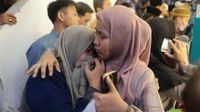On the afternoon of September 29, 2025, tragedy struck the Al Khoziny Islamic boarding school in Sidoarjo, East Java, Indonesia. What was meant to be a peaceful moment of prayer for more than 100 students turned into a harrowing ordeal, as the four-story prayer hall collapsed without warning, burying dozens under a mountain of steel, concrete, and dust. The building, which had been under construction and undergoing an unauthorized expansion, could not withstand the weight of its new floors, leading to a catastrophic failure that has left the community reeling.
According to reports from the Associated Press, the collapse occurred as hundreds of students were performing their afternoon prayers in the under-construction hall. Provincial police spokesperson Jules Abraham Abast detailed the sequence of events: "The old building’s foundation was apparently unable to support two floors of concrete and collapsed during the pouring process." The hall, originally a two-story structure, had been renovated with two additional floors—without the proper permit to build a new structure. This lack of oversight would prove disastrous.
Survivors recounted the chaos and fear that erupted in the seconds after the collapse. Most of the victims were male students, as female students were praying separately in another part of the building and managed to escape. The scene was one of devastation: children, many with head injuries and broken bones, were pulled from the rubble by residents, teachers, and administrators who rushed to help before the arrival of emergency services.
Emergency response was swift but fraught with challenges. Television reports showed dozens of rescue workers, police officers, and soldiers desperately digging through steel-reinforced concrete debris in search of survivors, supported by heavy equipment. Nanang Sigit, who led the rescue efforts, described the difficulties: heavy slabs of concrete and unstable parts of the building hampered their progress. "We have been running oxygen and water to those still trapped under the debris and keeping them alive while we work hard to get them out," Sigit said, emphasizing the urgency and gravity of the situation.
Families of the students gathered at hospitals and near the collapsed building, their faces etched with anxiety and grief. Some relatives wailed as they watched rescuers pull a dusty, injured student from the buried hall. The emotional toll was palpable, with a woman seen weeping and being comforted as rescue work continued into the night, as captured by AP photographer Trisnadi.
By the evening of September 29, the rescue operation had managed to pull four injured students from the debris, bringing the total number of injured to 83. However, the situation remained dire, as three children were still alive but trapped under the rubble. Rescuers provided them with oxygen and water, a lifeline in the darkness as efforts continued unabated. Sigit noted that several bodies had been seen scattered under the rubble, but the focus remained on saving those who could still be reached.
The numbers paint a grim picture. At least one male student was confirmed dead, while 99 other students were injured and taken to hospitals, some in critical condition, according to officials cited by Newsday. The toll could rise, as rescuers reported seeing additional bodies in the debris. Many of the injured suffered from head injuries and broken bones, a testament to the force of the collapse and the peril faced by those inside.
The incident has prompted an immediate investigation into the causes of the collapse. Authorities are scrutinizing the decision to expand the building without the necessary permits and whether proper construction standards were followed. Abast’s statement underscores the apparent recklessness: "The old building’s foundation was apparently unable to support two floors of concrete and collapsed during the pouring process." The expansion, which aimed to accommodate more students, instead exposed them to grave danger.
The rescue operation itself has been a massive undertaking. Several hundreds of rescuers, equipped with breathing apparatuses and medical evacuation tools, worked non-stop under hazardous conditions. The unstable remains of the building threatened to hinder their progress, but the determination to save lives was unwavering. The sight of rescuers pulling out eight weak and injured survivors more than eight hours after the collapse was a rare glimmer of hope amid the devastation.
This tragedy has shone a harsh light on the broader issue of building safety and regulatory oversight in Indonesia, particularly in the context of religious and educational institutions. The unauthorized expansion of the prayer hall at Al Khoziny Islamic boarding school is not an isolated incident in a country where rapid urbanization and population growth often outpace the enforcement of building codes. The consequences, as seen in Sidoarjo, can be catastrophic.
Community members, meanwhile, have rallied to support the victims and their families. Residents, teachers, and administrators were among the first to assist, pulling injured children from the rubble and providing first aid where possible. The collective response speaks to the resilience and compassion of the community, even as they grapple with profound loss and uncertainty.
As the investigation continues, questions abound. How could such an expansion proceed without proper authorization? Were warnings ignored, or were construction standards compromised in the rush to accommodate more students? The answers will be critical not only for the families of those affected but also for the broader effort to ensure such a tragedy does not happen again.
For now, the focus remains on rescue and recovery. The images of grieving families, exhausted rescuers, and injured students serve as a stark reminder of the human cost of negligence and the urgent need for accountability. As officials work to determine the full extent of the tragedy and its causes, the hope is that lessons will be learned, and that future generations of students will be spared such heartbreak.
The collapse at Al Khoziny Islamic boarding school stands as a somber testament to the importance of safety, oversight, and community in the face of disaster. The coming days will bring more answers—and, hopefully, more survivors—amid the rubble of what was meant to be a place of peace and prayer.






